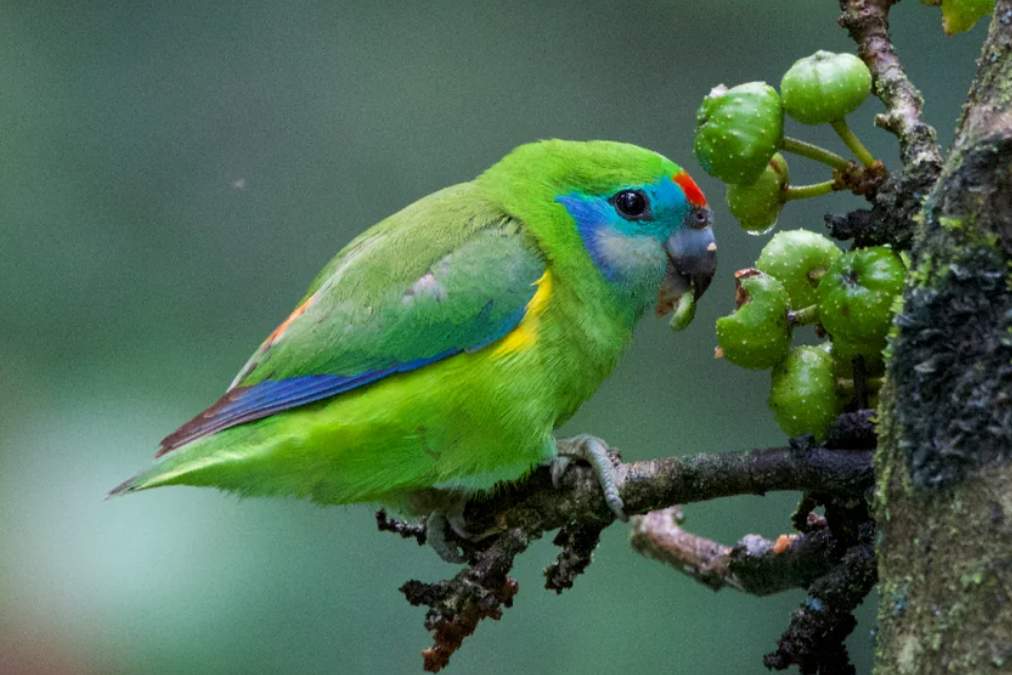Habitat: The Red-backed Kingfisher (Todiramphus pyrrhopygius) is better adapted to Australia’s desert lands than any of their relatives. Due to the fact that they obtain sufficient moisture from their food, they can live far from water. Their habitats include open mulga, mallee, dry coolabah-lined river beds, and low tropical woodlands and savanna. Their ability to survive in arid environments is largely due to their nomadic nature. When breeding, red-backed kingfishers usually live in loose groups of four or five or in dispersed pairs, but when not breeding they often live alone.

Migration: Red-backed Kingfishers are mostly migrants across southern Australia. In early spring, they appear in the south to breed, announcing their arrival with mournful whistles that echo through the arid woodlands. Toward the end of summer, they depart again. During the winter months, migrants from southern Australia mingle with residents.
Vocalizations: Red-backed Kingfisher calls are rather mournful, single-note whistles during breeding. Males may alter their calls from vantage points in trees and posts to promote territorial and self-advertising territory. A harsh, chauered sound is also heard when the nest is threatened. When not breeding, they are usually silent.
Diet: The majority of their diet consists of carnivorous insects, including grasshoppers, beetles, frogs, tiny crustaceans, centipedes, scorpions, and small reptiles. In addition to fish, frogs and tadpoles, lizards, snakes, and sometimes mouse-sized mammals, it also consumes vertebrates. The kingfishers catch their prey in the same manner as Forest and other land kingfishers: perched on bare branches, ant hills, or telegraph wires, they stare down motionless except for occasional head and tail bobs. They dive to catch prey and seize it on the ground when they see it.
Identification: John Gould, an English ornithologist and bird artist, described the red-backed kingfisher in 1841. The male head is streaked with dull blue-green and white merging into a dull white spot in front of each eye, bordered by a broader black band running through the eyes to ear coverts and back of neck.
The collar is white, often rufous-tinted. The mantle is dull turquoise-blue, sometimes rufous-tinted. Rump and upper tail coverts are rufous. Tail dull turquoise-blue above, paler and grey-tinted below. Wings are light turquoise-blue to cerulean-blue on the shoulders. Most flight feathers are edged with turquoise on the outer web, grading to dusky on the inner web. The entire under-surface is white, often dirty. Eyes are dark brown. The bill is black with a flesh-colored mandible base. Feet are dark olive-grey to dusky.
Female birds’ crowns, mantle, wings, and tails are duller and greyer. Usually no rufous tint on the collar. The immature bird is similar to the female on the upper surface; sides of the under-surface and white collar lightly scalloped or marked with dusky grey; shoulders lightly flecked with white.

Nest & Breed: Breeding and nesting occur between August and February, mainly in October and November. A nest is a burrow, 300-600 mm long and 80-120 mm wide, usually dug in the soft bank of a creek, less often in termite hills or mounds in trees. An unlined nest chamber is located at the end of an upward-running burrow, 200-250 mm in diameter and 150 mm in height.
Nest drilling appears to be done by both sexes, as is the case with Forest Kingfishers. The female is responsible for incubating the eggs and raising the young, while the male is responsible for raising the young by day. Forest Kingfishers often do not defend their nest from intruders as vigorously as their female counterparts. About a week after hatching, young begin to gain pin feathers.
Eggs & Incubation: The bird lays 3 to 5 eggs; smooth, dull pure white; broadly oval or almost spherical, about 27 x 23 mm. Eggs are laid on powdered earth or termite mound rubble on the nest chamber floor. Incubation takes about 20 days, for both sexes, beginning with the laying of the first egg. Young wings open in just over three weeks.
Distribution: Throughout most of inland Australia and the coast, except for southeast, southwest, and Tasmania, except as stragglers in open mulga, mallee, dry streambeds, low tropical woodlands, and savannas.
Flight: Red-backed Kingfisher flight is swift and direct like other kingfishers.
Alternative names: It is also known as the tree kingfisher.
Size: Red-backed Kingfishers measure about 200-240 mm in length. Males weigh 45-70 grams and females weigh 41-62 grams.
Races: There are no races.
Family: The red-backed kingfisher is belong to the subfamily Halcyoninae.
Read More – Buff-breasted Paradise-Kingfisher







